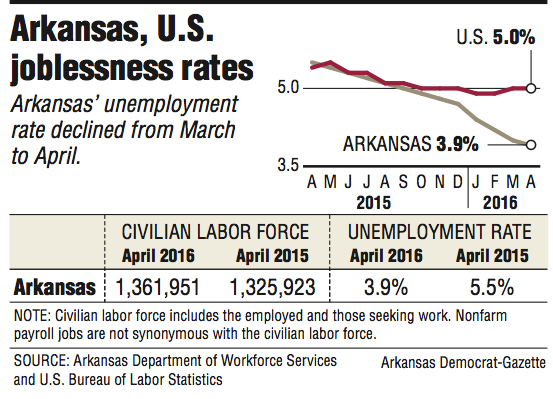Arkansas' unemployment rate fell to 3.9 percent in April, dropping below 4 percent for the first time since reports were issued, the U.S. Bureau of Labor Statistics said Friday.
It declined from 4.1 percent in March -- a rate that was revised from the originally reported 4.0 percent for March.
The national unemployment rate in April was 5 percent.
Since 1957, as far back as employment figures are available, Arkansas' unemployment rate has never been below 4 percent, according to the bureau.
Unemployment data was published only in annual reports to the president from 1957 to 1975, and those reports included only annual unemployment rates for the states, a spokesman with the bureau said. Since 1976, the bureau has reported monthly rates for each state, the spokesman said.
Before April's 3.9 percent unemployment rate, the lowest previously recorded rate in Arkansas was 4.1 percent, both in March and in the annual unemployment rate for 1969.
"3.9 percent -- holy moly," said Kathy Deck, director of the Center for Business and Economic Research at the University of Arkansas in Fayetteville. "It is unbelievable, and it's all good. The labor force continues to improve. We see employment at record high levels. The Arkansas economy is performing as well as you can hope for from an employment perspective."
The number of employed Arkansans reached a record high last month of 1,309,268, said Susan Price, a spokesman for the Arkansas Department of Workforce Services. The previous record was 1,304,511 in May 2008, Price said. The number of employed in the state increased more than 56,170 from April 2015.
The strength in the state's employment numbers is broad-based, both in urban and rural areas, Deck said.
"Central Arkansas, Northwest Arkansas and Jonesboro are leading the way at the top of their game," Deck said. "But some of the rural areas are holding their own."
The metropolitan unemployment rates vary considerably, said Michael Pakko, chief economist at the Institute for Economic Advancement at the University of Arkansas at Little Rock.
Northwest Arkansas' unemployment rate for March was at 2.9 percent. Jonesboro's was 3.5 percent. Little Rock's was 3.6 percent, and Pine Bluff's was 5.4 percent.
"What is making these numbers look so good is that not all of the job growth is coming in the metro areas," Deck said.
The labor force, which includes the employed and the unemployed who are seeking work, was 1,361,951, up more than 36,000 in the past year. That's as high as it's been since January 2012.
But when the unemployed who have stopped looking for work and those working part-time for economic reasons are included, the unemployment rate is closer to 9 percent in Arkansas and the nation, said John Shelnutt, administrator for economic analysis and tax research for the state's Department of Finance and Administration.
"That indicates there is still some slackness in the labor market," Shelnutt said.
The labor force participation rate -- the percentage of working-age citizens who are working and those actively seeking work -- is at about 62 percent, which is low by historical standards, Shelnutt said. A healthier percentage would be 64 percent to 65 percent, Shelnutt said.
Nine employment sectors had an increase in jobs in the past year, and two reported declines.
The trade, transportation and utilities sector added 8,800 jobs since April last year. The sector includes retail, which accounts for more than half the jobs in the sector.
Three sectors -- professional and business services, educational and health services, and the leisure and hospitality sector -- each added 5,300 jobs in since April.
The two sectors that had a decline in jobs since April last year are mining, which lost 1,400 jobs, and manufacturing, which lost 1,300 jobs. Those two sectors have been weak throughout the economic expansion, Pakko said.
"We certainly haven't seen any significant rebound in manufacturing, but at the same time it has kind of stabilized from a long period of decline," Pakko said.
South Dakota had the lowest unemployment rate in April at 2.5 percent, followed by New Hampshire at 2.6 percent, Nebraska at 3.0 percent and Colorado at 3.1 percent.
Alaska and Illinois had the highest rates in April at 6.6 percent each, followed by West Virginia at 6.4 percent, Louisiana at 6.3 percent and New Mexico at 6.2 percent.
Arkansas and Tennessee had the country's biggest declines in unemployment rates from April last year at 1.6 percentage point each.
Business on 05/21/2016
